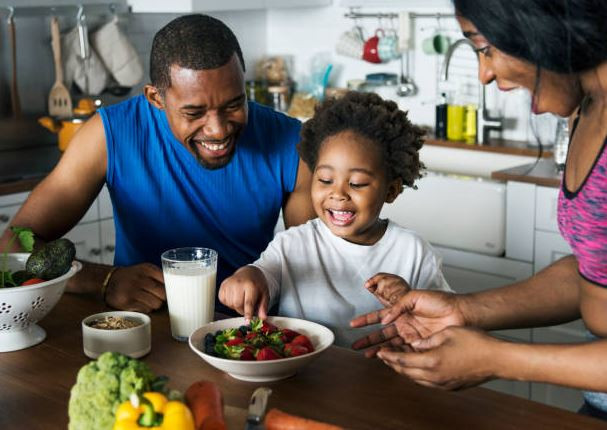
When Jessica Otieno got married to Robert Otieno eight years ago, their first family goal was to raise a family of five children. Despite the hard economic times, they were determined to score this goal. After all, they both had been brought up in large families. Robert was from a family of 11, while Jessica was from a family of eight.
The young couple had a better idea. They would have their children within a spacing period of two years so they could raise their children early and then settle down to enjoy life. They were wrong. What Robert and Jessica did not know at the time was that bringing up five toddlers was going to be challenging, especially cooking for them.
“We learnt the hard way when our last-born daughter, Sharleen now aged two years arrived, while our eldest son Nicholas was six, Maxwell our second born was four years, and Mark-Ouma our third born was two years then,” says the mother of four.
Then came trouble, says Robert. The four toddlers had different appetites. “When Sharleen arrived, she seemed to have triggered an insatiable appetite during breastfeeding, and we had to introduce her to baby milk and food at three years,” says Robert.
On the other hand, the other three siblings went on a rampage crying and throwing tantrums over food. It was either they did not like certain food, or when they did like it, their appetites were insatiable.
The toddlers Jessica says, seemed to have a mind of their own on food issues. She says they would like something one day and not the next. One of them might like a particular food that the other hates.
The tantrums were unbearable, and the couple says it cost them six house helps before Jessica finally left employment to be a stay-at-home mother. Even then things were still rough.
Lisa Wanjiro a family counsellor, says in a busy household, parents are pushed for time even without factoring in children’s notorious fussiness.
- World Vision launches 'ENOUGH' campaign to tackle hunger, malnutrition in Kenya
- Eating junk food during childhood may lead to irreversible memory issues
- Indian naval ship docks with relief food and medicine
- Calls for mandatory front-of-pack warning labels on infant food products
Keep Reading
“There’s research to back up the anecdotal evidence and several studies suggest that children could be influencing the amount of food waste generated in the home, from unfinished meals, buying more than is needed to provide a wide selection of food for the children, to intentionally cooking more than may be needed,” says the counsellor
In such scenarios, she advises, anything the parent or caregiver can do to lighten the load in the kitchen can be a good thing to save on food and take away the pressure.
Tips to save time and food
Encourage the children to help in the kitchen. Children are sometimes difficult to understand, but easy to tame. Even when you have put your best foot forward in the preparation of a meal, your children might wear their “disgusting” faces at the food you’ve cooked.
However, says Wanjiro, when the tables are turned and it’s them preparing the food, they’ll lick the plate clean. Once they’ve washed the dishes or stirred the sauce themselves, you may have more luck with getting them to eat it all up.
“Never underestimate the power of involving children in meal preparation when you can as not only is it teaching them a valuable life skill, but it’s a great way to fire up their enthusiasm for all things culinary and to help them appreciate how their meals reach the table,” says the expert.
Meal planning and portion control: Experts advise parents to devote a few minutes at the beginning of the week to work on a meal plan for the week. This will give you headway on what to cook when you are tired at the end of the day and the toddlers are hungry.
Meal planning makes it easier to make sure you use up what you have in the fridge, freezer, and cupboards, as well as helping you work out what you need to buy from the shop so that you don’t end up buying more than you need.
Another way to keep portion sizes under control is to buy frozen food (you could do it yourself). This allows you to take out only what you need – such as the exact quantity of peas from a bigger bag, and keep the rest in the freezer for another day.
When it comes to mealtimes, as a general rule it’s best to serve small portions, allowing second helpings if they’re asking for more. Giving children the opportunity to serve themselves from a central serving dish so they only take what they.
For the busy parent, batch cooking is a fantastic way to get ahead, enabling you to enjoy a few stress-free evenings where you only have to reheat what you have already cooked.
There are lots of child-friendly dishes that lend themselves beautifully to batch cooking, such as pasta (or just the pasta sauce), stews and casseroles, mild chili con carne, and risotto.
Work with your leftovers: Keep the leftovers and use them to lighten your load another day. Whether you reuse boiled potatoes by frying them up as a tasty side for your grown-up meal, or you serve up leftover carrot batons as snacks, there is always something delicious you can do with anything that’s left over.
You can use fruit leftovers in baking – such as pancakes, muffins, and cupcakes.
 The Standard Group Plc is a multi-media organization with investments in media platforms spanning newspaper print
operations, television, radio broadcasting, digital and online services. The Standard Group is recognized as a
leading multi-media house in Kenya with a key influence in matters of national and international interest.
The Standard Group Plc is a multi-media organization with investments in media platforms spanning newspaper print
operations, television, radio broadcasting, digital and online services. The Standard Group is recognized as a
leading multi-media house in Kenya with a key influence in matters of national and international interest.











